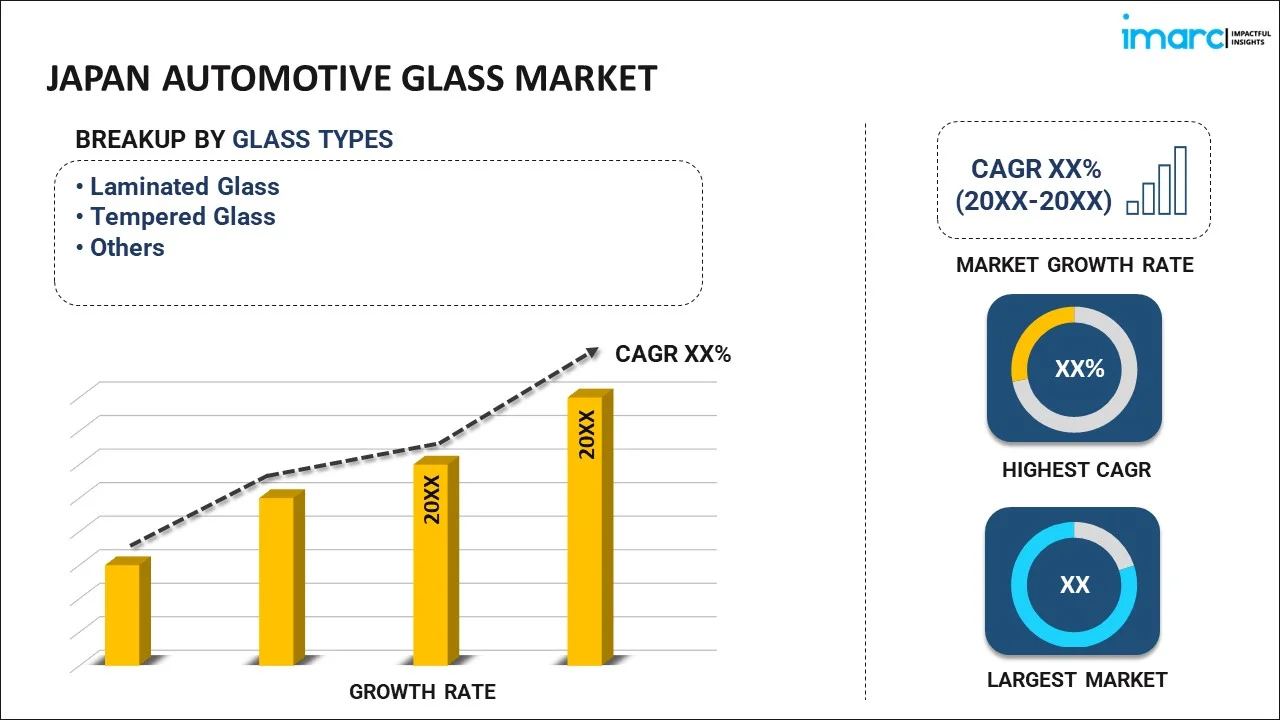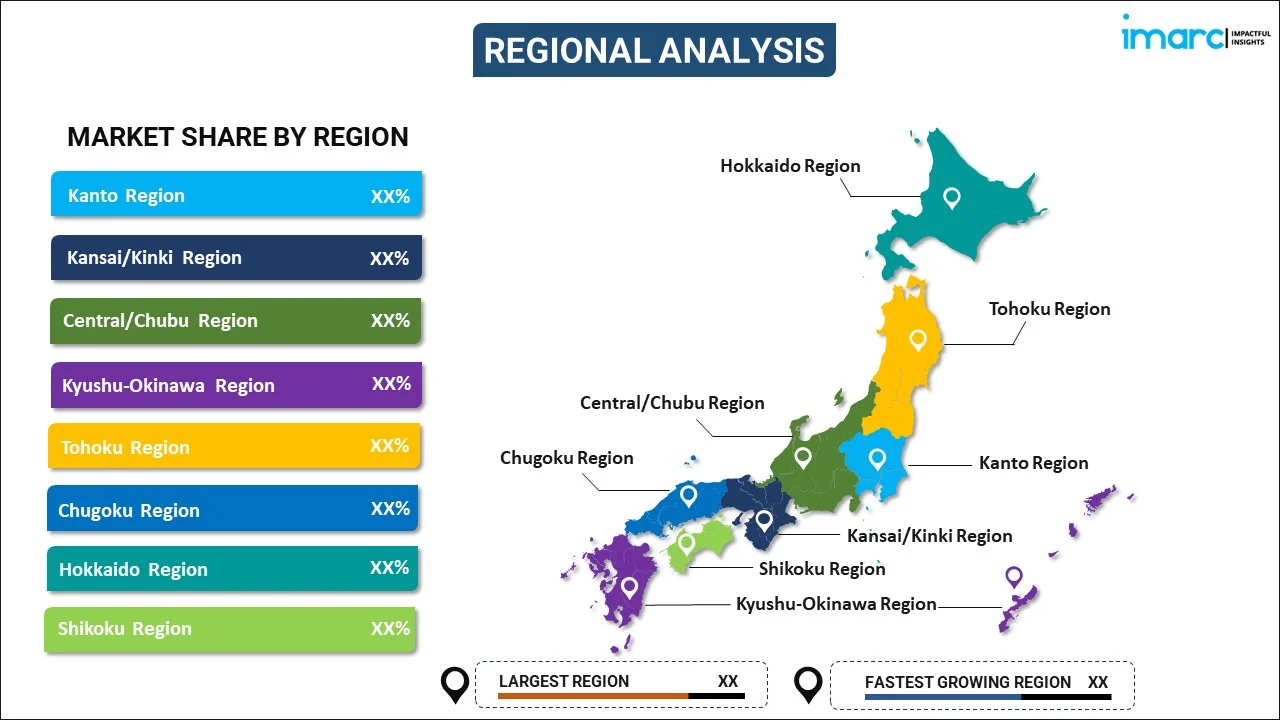
Japan Automotive Glass Market Report by Glass Type (Laminated Glass, Tempered Glass, and Others), Material Type (IR PVB, Metal Coated Glass, Tinted Glass, and Others), Vehicle Type (Passenger Cars, Light Commercial Vehicles, Trucks, Buses, and Others), Technology (Active Smart Glass, Passive Glass), Application (Windshield, Sidelite, Backlite, Rear Quarter Glass, Sideview Mirror, Rearview Mirror, and Others), End User (OEMs, Aftermarket), and Region 2025-2033
Market Overview:
Japan automotive glass market size reached USD 1,136 Million in 2024. Looking forward, IMARC Group expects the market to reach USD 1,920 Million by 2033, exhibiting a growth rate (CAGR) of 6% during 2025-2033. The increasing ownership of passenger and commercial vehicles, integration of advanced driver-assistance systems (ADAS) in vehicles, and the growing emphasis on safety and innovation in the automotive sector represent some of the key factors driving the market.
|
Report Attribute
|
Key Statistics
|
|---|---|
|
Base Year
|
2024 |
|
Forecast Years
|
2025-2033 |
|
Historical Years
|
2019-2024
|
| Market Size in 2024 | USD 1,136 Million |
| Market Forecast in 2033 | USD 1,920 Million |
| Market Growth Rate (2025-2033) | 6% |
Automotive glass is highly transparent, allowing drivers and passengers to have a clear view of the road and surroundings. It ensures optimal visibility for drivers, improving road safety, and reducing the risk of injuries in case of accidents. It can withstand various environmental factors, including extreme temperatures and impacts from debris on the road. It has sound-insulating properties, reducing external noise levels inside the vehicle for a more comfortable driving experience. It is equipped with UV protection, minimizing the risk of skin damage and interior fading. It is widely used for headlight and taillight covers, protecting the bulbs and providing optical clarity. Besides this, as it is non-porous, highly recyclable, consumes minimal power, and contributes to environmental health during manufacturing, the demand for automotive glass is increasing across Japan.
Japan Automotive Glass Market Trends:
Rapid urbanization and the increasing ownership of passenger and commercial vehicles in Japan represent one of the key factors influencing the market positively. Additionally, the expanding sales of electric vehicles (EVs) due to the growing environmental concerns are catalyzing the demand for specialized glass for reduced cabin noise and increased energy efficiency. Along with this, the growing emphasis on safety and innovation in the automotive sector has increased the adoption of advanced automotive glass technologies, including laminated glass for windshields and tempered glass for side windows, enhancing safety and aesthetics. Apart from this, the rising shift towards eco-friendly transportation is catalyzing the demand for lightweight, energy-efficient glass solutions, such as smart glass, that can regulate light and heat transmission. These innovations improve fuel efficiency and contribute to a more comfortable and eco-conscious driving experience. Furthermore, the integration of advanced driver-assistance systems (ADAS) in vehicles is strengthening the growth of the market. ADAS relies heavily on sensors and cameras, many of which require precise calibration and positioning behind the windshield. Moreover, the development of anti-glare coatings and improved anti-fog properties in automotive glass is bolstering the market growth. Besides this, the rising need for advanced sensors, LiDAR, and communication technologies embedded in automotive glass is creating a positive outlook for the market. Furthermore, the well-established infrastructure for research and development (R&D) in the country fosters innovation in automotive glass technology. Additionally, rising collaborations between glass manufacturers, automotive companies, and research institutions in Japan are promoting the development of lightweight materials and energy-efficient coatings. Furthermore, continuous innovations in automotive glass technology, including the development of smart glass with features like self-tinting and heads-up displays, are attracting a wider consumer base.
Japan Automotive Glass Market Segmentation:
IMARC Group provides an analysis of the key trends in each segment of the market, along with forecasts at the country level for 2025-2033. our report has categorized the market based on glass type, material type, vehicle type, technology, application, and end user.
Glass Type Insights:

- Laminated Glass
- Tempered Glass
- Others
The report has provided a detailed breakup and analysis of the market based on the glass type. This includes laminated glass, tempered glass, and others.
Material Type Insights:
- IR PVB
- Metal Coated Glass
- Tinted Glass
- Others
A detailed breakup and analysis of the market based on the material type have also been provided in the report. This includes IR PVB, metal coated glass, tinted glass, and others.
Vehicle Type Insights:
- Passenger Cars
- Light Commercial Vehicles
- Trucks
- Buses
- Others
The report has provided a detailed breakup and analysis of the market based on the vehicle type. This includes passenger cars, light commercial vehicles, trucks, buses, and others.
Technology Insights:
- Active Smart Glass
- Suspended Particle Glass
- Electrochromic Glass
- Liquid Crystal Glass
- Passive Glass
- Thermochromic
- Photochromic
A detailed breakup and analysis of the market based on the technology have also been provided in the report. This includes active smart glass (suspended particle glass, electrochromic glass, and liquid crystal glass) and passive glass (thermochromic and photochromic).
Application Insights:
- Windshield
- Sidelite
- Backlite
- Rear Quarter Glass
- Sideview Mirror
- Rearview Mirror
- Others
The report has provided a detailed breakup and analysis of the market based on application. This includes windshield, sidelite, backlite, rear quarter glass, sideview mirror, rearview mirror, and others.
End User Insights:
- OEMs
- Aftermarket
A detailed breakup and analysis of the market based on the end user have also been provided in the report. This includes OEMs and aftermarket.
Regional Insights:

- Kanto Region
- Kansai/Kinki Region
- Central/ Chubu Region
- Kyushu-Okinawa Region
- Tohoku Region
- Chugoku Region
- Hokkaido Region
- Shikoku Region
The report has also provided a comprehensive analysis of all the major regional markets, which include Kanto Region, Kansai/Kinki Region, Central/ Chubu Region, Kyushu-Okinawa Region, Tohoku Region, Chugoku Region, Hokkaido Region, and Shikoku Region.
Competitive Landscape:
The market research report has also provided a comprehensive analysis of the competitive landscape. Competitive analysis such as market structure, key player positioning, top winning strategies, competitive dashboard, and company evaluation quadrant has been covered in the report. Also, detailed profiles of all major companies have been provided.
Japan Automotive Glass Market Report Coverage:
| Report Features | Details |
|---|---|
| Base Year of the Analysis | 2024 |
| Historical Period | 2019-2024 |
| Forecast Period | 2025-2033 |
| Units | Million USD |
| Scope of the Report | Exploration of Historical and Forecast Trends, Industry Catalysts and Challenges, Segment-Wise Historical and Predictive Market Assessment:
|
| Glass Types Covered | Laminated Glass, Tempered Glass, Others |
| Material Types Covered | IR PVB, Metal Coated Glass, Tinted Glass, Others |
| Vehicle Types Covered | Passenger Cars, Light Commercial Vehicles, Trucks, Buses, Others |
| Technologies Covered |
|
| Applications Covered | Windshield, Sidelite, Backlite, Rear Quarter Glass, Sideview Mirror, Rearview Mirror, Others |
| End Users Covered | OEMs, Aftermarket |
| Regions Covered | Kanto Region, Kansai/Kinki Region, Central/ Chubu Region, Kyushu-Okinawa Region, Tohoku Region, Chugoku Region, Hokkaido Region, Shikoku Region |
| Customization Scope | 10% Free Customization |
| Post-Sale Analyst Support | 10-12 Weeks |
| Delivery Format | PDF and Excel through Email (We can also provide the editable version of the report in PPT/Word format on special request) |
Key Questions Answered in This Report:
- How has the Japan automotive glass market performed so far and how will it perform in the coming years?
- What has been the impact of COVID-19 on the Japan automotive glass market?
- What is the breakup of the Japan automotive glass market on the basis of glass type?
- What is the breakup of the Japan automotive glass market on the basis of material type?
- What is the breakup of the Japan automotive glass market on the basis of vehicle type?
- What is the breakup of the Japan automotive glass market on the basis of technology?
- What is the breakup of the Japan automotive glass market on the basis of application?
- What is the breakup of the Japan automotive glass market on the basis of end user?
- What are the various stages in the value chain of the Japan automotive glass market?
- What are the key driving factors and challenges in the Japan automotive glass?
- What is the structure of the Japan automotive glass market and who are the key players?
- What is the degree of competition in the Japan automotive glass market?
Key Benefits for Stakeholders:
- IMARC’s industry report offers a comprehensive quantitative analysis of various market segments, historical and current market trends, market forecasts, and dynamics of the Japan automotive glass market from 2019-2033.
- The research report provides the latest information on the market drivers, challenges, and opportunities in the Japan automotive glass market.
- Porter's five forces analysis assist stakeholders in assessing the impact of new entrants, competitive rivalry, supplier power, buyer power, and the threat of substitution. It helps stakeholders to analyze the level of competition within the Japan automotive glass industry and its attractiveness.
- Competitive landscape allows stakeholders to understand their competitive environment and provides an insight into the current positions of key players in the market.
Need more help?
- Speak to our experienced analysts for insights on the current market scenarios.
- Include additional segments and countries to customize the report as per your requirement.
- Gain an unparalleled competitive advantage in your domain by understanding how to utilize the report and positively impacting your operations and revenue.
- For further assistance, please connect with our analysts.
 Inquire Before Buying
Inquire Before Buying
 Speak to an Analyst
Speak to an Analyst
 Request Brochure
Request Brochure
 Request Customization
Request Customization




.webp)




.webp)












